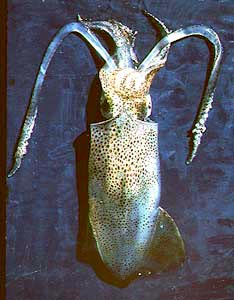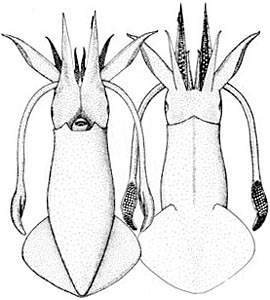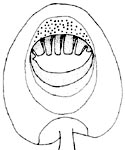Lolliguncula
Brief squids
Michael Vecchione and Richard E. Young


This tree diagram shows the relationships between several groups of organisms.
The root of the current tree connects the organisms featured in this tree to their containing group and the rest of the Tree of Life. The basal branching point in the tree represents the ancestor of the other groups in the tree. This ancestor diversified over time into several descendent subgroups, which are represented as internal nodes and terminal taxa to the right.

You can click on the root to travel down the Tree of Life all the way to the root of all Life, and you can click on the names of descendent subgroups to travel up the Tree of Life all the way to individual species.
For more information on ToL tree formatting, please see Interpreting the Tree or Classification. To learn more about phylogenetic trees, please visit our Phylogenetic Biology pages.
close boxIntroduction
Species of Lolliguncula are rather small squids that generally occupy warm, shallow waters and some invade regions of low salinity.
Brief diagnosis:
A loliginid ...
- with short mantle, rounded posteriorly; fins wider than long but without posterior lobes.
- with a long cement body in the spermatophores.
- without ventral crest on hectocotylus.
- with distribution only in American waters.
Characteristics
- Arms
- Sucker rings with square teeth on distal or entire margin.
- Suckers on mid-sections of lateral arms of males not greatly enlarged.
- Hectocotylus:
- Ventral crest absent.
- Unmodified proximal region of hectocotylus present (in subgenus Lolliguncula) or absent (in subgenus Loliolopsis).
- Suckers of modified region reduced, sucker stalks elongated to form papillae on either dorsal or both dorsal and ventral rows.
- Tentacles
- Tentacular clubs expanded, suckers in four series.
- Tentacular clubs expanded, suckers in four series.
- Mantle
- Mantle posteriorly rounded; posterior tail-like elongation absent.
- Mantle posteriorly rounded; posterior tail-like elongation absent.
- Fins
- Fins posterior, broadly rounded posteriorly.
- Fins wider than long in adults.
- Photophores
- Photophores absent.
- Photophores absent.
- Viscera
- Eggs less than 3mm.
- Spermatophore cement body long.
Comments
The cement body of Lolliguncula species, where known, varies roughly between 30-50% of the spermatophore length. In other loliginid genera with small cement bodies, the cement body typically is between about 3-15% of the spermatophore lenght.
Members of Lolliguncula (Lolliguncula) have the modified portion of the hectocotylus less than the entire arm (ie, the proximal portion is not modified) while Lolliguncula (Loliolopsis) has the hectocotylus modified along the entire arm.
Nomenclature
Berry (1929) described a new species that he named chiroctes and erected the genus Loliolopsis because of the distinctiveness of the new species. Voss (1971) recognized that L. chiroctes is a junior synonym of Hoyle's Loligo diomedeae but that Berry was correct in establishing a new genus. Therefore, the type species of Loliolopsis (now a subgenus of Lolliguncula) is Loliolopsis diomedeae (Hoyle, 1904).
Discussion of Phylogenetic Relationships
The genus Lolliguncula was established to distinguish L. brevis from the species of Loligo then known, based on body and fin shape and spermatophore deposition site. These characters have since proven to exhibit considerable variability, both within and among species. However, all of the species in this genus are united and distinguished from all other loliginids by the long cement body of their spermatophores. Variability exists in hectocotylus morphology, and this led Berry (1929) to erect the genus Loliolopsis and Brakoniecki (1986) to erect Afrololigo. This variability is extreme in L. diomedeae, but Brakoniecki (1986) has pointed out the similarities in hectocotylization between this species and the others of Lolliguncula.
Many of the morphological characters of Afrololigo mercatoris are shared with species of Lolliguncula, the genus in which it was originally described. However, DNA sequence analysis by Anderson (2000) supports Brakoniecki's (1986) conclusion based on hectocotylus morphology that Afrololigo is a distinct genus.
Distribution
These are all American species, with their low-latitude distribution centered at Panama. One species, L. brevis, is found on the Atlantic side of the Americas whereas three, L. panamensis, L. diomedeae and L. argus are found on the Pacific side. All of these species are found in warm, shallow, inshore waters. The genus is noteworthy among cephalopods for its euryhalinity.
References
Alexeyev, D.O. 1992. The Systematic Position of Bioluminescent Squids of the Family Loliginidae (Cephalopoda, Myopsida). Zoologeskiy Zhurnal, 71(11):12-23. (In Russian).
Berry, S.S. 1929. Loliolopsis chiroctes, a New Genus and Species of Squid from the Gulf of California. Transactions of the San Diego Society of Natural History, 5(18):263-282, plates 32-33.
Brakoniecki, T.F. 1986. A Generic Revision of the Family Loliginidae (Cephalopoda; Myopsida) Based Primarily on the Comparative Morphology of the Hectocotylus. Ph.D. Dissertation, University of Miami, Miami, FL, USA. 163 pages.
Vecchione, M., T. F. Brakoniecki, Y. Natsukari and R. T. Hanlon. 1998. A Provisional Generic Classification of the Family Loliginidae. Smithson. Contr. Zool., 586: 215-222.
Vecchione, M., E. Shea, S. Bussarawit, F. Anderson, D. Alexeyev, C.-C. Lu, T. Okutani, M. Roeleveld, C. Chotiyaputta, C. Roper, E. Jorgensen and N. Sukramongkol. 2005. Systematics of Indo-West Pacific loliginids. Phuket Mar. Biol. Cent. Res. Bull. 66: 23-26.
Voss, G. L. 1971. Cephalopods collected by the R/V JOHN ELLIOTT PILLSBURY in the Gulf of Panama in 1967. Bull. Mar. Sci. 21:1-34.
Title Illustrations

| Scientific Name | Lollicuncula brevis |
|---|---|
| Specimen Condition | Dead Specimen |
| View | Dorsal |
| Copyright | © 1996 Gus Stacy |
| Scientific Name | Lollicuncula brevis |
|---|---|
| Reference | Vecchione, M., C. F. E. Roper and M. J. Sweeney (1989). Marine flora and fauna of the eastern United States. Mollusca: Cephalopoda. NOAA Tech. Rep., NMFS 73: 23 pp. |
| View | Ventral, dorsal |
| Image Use |
 This media file is licensed under the Creative Commons Attribution-NonCommercial License - Version 3.0. This media file is licensed under the Creative Commons Attribution-NonCommercial License - Version 3.0.
|
| Copyright |
©

|
About This Page

National Museum of Natural History, Washington, D. C. , USA

University of Hawaii, Honolulu, HI, USA
Correspondence regarding this page should be directed to Michael Vecchione at
Page copyright © 2018
 Page: Tree of Life
Lolliguncula . Brief squids.
Authored by
Michael Vecchione and Richard E. Young.
The TEXT of this page is licensed under the
Creative Commons Attribution-NonCommercial License - Version 3.0. Note that images and other media
featured on this page are each governed by their own license, and they may or may not be available
for reuse. Click on an image or a media link to access the media data window, which provides the
relevant licensing information. For the general terms and conditions of ToL material reuse and
redistribution, please see the Tree of Life Copyright
Policies.
Page: Tree of Life
Lolliguncula . Brief squids.
Authored by
Michael Vecchione and Richard E. Young.
The TEXT of this page is licensed under the
Creative Commons Attribution-NonCommercial License - Version 3.0. Note that images and other media
featured on this page are each governed by their own license, and they may or may not be available
for reuse. Click on an image or a media link to access the media data window, which provides the
relevant licensing information. For the general terms and conditions of ToL material reuse and
redistribution, please see the Tree of Life Copyright
Policies.
- Content changed 02 September 2010
Citing this page:
Vecchione, Michael and Richard E. Young. 2010. Lolliguncula . Brief squids. Version 02 September 2010 (under construction). http://tolweb.org/Lolliguncula/19860/2010.09.02 in The Tree of Life Web Project, http://tolweb.org/












 Go to quick links
Go to quick search
Go to navigation for this section of the ToL site
Go to detailed links for the ToL site
Go to quick links
Go to quick search
Go to navigation for this section of the ToL site
Go to detailed links for the ToL site